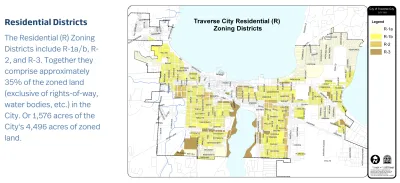Zoning changes for everything from housing density to minimum lot sizes are under consideration for a city on the shores of Lake Michigan.

Traverse City, Michigan is considering a package of zoning changes that would increase housing density and diversity by removing the existing cap on the number of allowable accessory dwelling units, among other changes.
“ADUs are currently capped at 15 annually, a number City Planning Director Shawn Winter has called ‘completely arbitrary,’” according to an article by Beth Milligan. “Another change would lift an owner occupancy requirement on ADUs, which stipulates that the property owner must live full-time in either the main house or the ADU.”
ADUs aren’t the only subject of the changes, however. The changes also “include allowing ADUs with a duplex, reducing the minimum land area for cluster housing, and allowing duplexes by right in the R-1a/b residential districts – which make up nearly 83 percent of all residential land in the city,” reports Milligan. “Triplexes and quadplexes would be allowed by right in the R-2 district, with ADUs allowed with duplexes and triplexes in R-2. The proposal also reduces the minimum lot width and area in the R-1a/b districts and allows two homes to be built on a lot that is twice the minimum area without being split.”
Opponents, organized under the moniker of the Alliance of Citizens for Traverse City have launched a website that describes the series of reforms as “blanket changes” and criticizing the market-based approach to housing. “Other cities that implemented these blanket zoning changes experienced skyrocketing property values (and taxes), gentrification, and loss of green spaces,” reads the website without mentioning specifics.
Research on the effects of ADU legalization and reduced minimum lot sizes was published by the Office of Policy Development and Research’s Cityscape journal.
The city’s planning commission approved the changes earlier this year. A public hearing conducted by the city commission earlier this week attracted a crowd ahead of an October 16 deadline for a date.
FULL STORY: Housing Zoning Changes Go Before City Commission

National Parks Layoffs Will Cause Communities to Lose Billions
Thousands of essential park workers were laid off this week, just before the busy spring break season.

Retro-silient?: America’s First “Eco-burb,” The Woodlands Turns 50
A master-planned community north of Houston offers lessons on green infrastructure and resilient design, but falls short of its founder’s lofty affordability and walkability goals.

Delivering for America Plan Will Downgrade Mail Service in at Least 49.5 Percent of Zip Codes
Republican and Democrat lawmakers criticize the plan for its disproportionate negative impact on rural communities.

Test News Post 1
This is a summary

Test News Headline 46
Test for the image on the front page.

Balancing Bombs and Butterflies: How the National Guard Protects a Rare Species
The National Guard at Fort Indiantown Gap uses GIS technology and land management strategies to balance military training with conservation efforts, ensuring the survival of the rare eastern regal fritillary butterfly.
Urban Design for Planners 1: Software Tools
This six-course series explores essential urban design concepts using open source software and equips planners with the tools they need to participate fully in the urban design process.
Planning for Universal Design
Learn the tools for implementing Universal Design in planning regulations.
EMC Planning Group, Inc.
Planetizen
Planetizen
Mpact (formerly Rail~Volution)
Great Falls Development Authority, Inc.
HUDs Office of Policy Development and Research
NYU Wagner Graduate School of Public Service





























